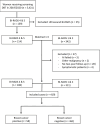AI-enhanced Mammography With Digital Breast Tomosynthesis for Breast Cancer Detection: Clinical Value and Comparison With Human Performance
- PMID: 38995172
- PMCID: PMC11287230
- DOI: 10.1148/rycan.230149
AI-enhanced Mammography With Digital Breast Tomosynthesis for Breast Cancer Detection: Clinical Value and Comparison With Human Performance
Abstract
Purpose To compare two deep learning-based commercially available artificial intelligence (AI) systems for mammography with digital breast tomosynthesis (DBT) and benchmark them against the performance of radiologists. Materials and Methods This retrospective study included consecutive asymptomatic patients who underwent mammography with DBT (2019-2020). Two AI systems (Transpara 1.7.0 and ProFound AI 3.0) were used to evaluate the DBT examinations. The systems were compared using receiver operating characteristic (ROC) analysis to calculate the area under the ROC curve (AUC) for detecting malignancy overall and within subgroups based on mammographic breast density. Breast Imaging Reporting and Data System results obtained from standard-of-care human double-reading were compared against AI results with use of the DeLong test. Results Of 419 female patients (median age, 60 years [IQR, 52-70 years]) included, 58 had histologically proven breast cancer. The AUC was 0.86 (95% CI: 0.85, 0.91), 0.93 (95% CI: 0.90, 0.95), and 0.98 (95% CI: 0.96, 0.99) for Transpara, ProFound AI, and human double-reading, respectively. For Transpara, a rule-out criterion of score 7 or lower yielded 100% (95% CI: 94.2, 100.0) sensitivity and 60.9% (95% CI: 55.7, 66.0) specificity. The rule-in criterion of higher than score 9 yielded 96.6% sensitivity (95% CI: 88.1, 99.6) and 78.1% specificity (95% CI: 73.8, 82.5). For ProFound AI, a rule-out criterion of lower than score 51 yielded 100% sensitivity (95% CI: 93.8, 100) and 67.0% specificity (95% CI: 62.2, 72.1). The rule-in criterion of higher than score 69 yielded 93.1% (95% CI: 83.3, 98.1) sensitivity and 82.0% (95% CI: 77.9, 86.1) specificity. Conclusion Both AI systems showed high performance in breast cancer detection but lower performance compared with human double-reading. Keywords: Mammography, Breast, Oncology, Artificial Intelligence, Deep Learning, Digital Breast Tomosynthesis © RSNA, 2024.
Keywords: Artificial Intelligence; Breast; Deep Learning; Digital Breast Tomosynthesis; Mammography; Oncology.
Conflict of interest statement
Figures




Comment in
-
AI Systems for Mammography with Digital Breast Tomosynthesis: Expectations and Challenges.Radiol Imaging Cancer. 2024 Jul;6(4):e240171. doi: 10.1148/rycan.240171. Radiol Imaging Cancer. 2024. PMID: 39058299 Free PMC article. No abstract available.
References
-
- Ferlay J , Colombet M , Soerjomataram I , et al. . Estimating the global cancer incidence and mortality in 2018: GLOBOCAN sources and methods . Int J Cancer 2019. ; 144 ( 8 ): 1941 – 1953 . - PubMed
-
- Siegel RL , Miller KD , Wagle NS , Jemal A . Cancer statistics, 2023 . CA Cancer J Clin 2023. ; 73 ( 1 ): 17 – 48 . - PubMed
-
- Baker JA , Rosen EL , Lo JY , Gimenez EI , Walsh R , Soo MS . Computer-aided detection (CAD) in screening mammography: sensitivity of commercial CAD systems for detecting architectural distortion . AJR Am J Roentgenol 2003. ; 181 ( 4 ): 1083 – 1088 . - PubMed
-
- Baker JA , Lo JY , Delong DM , Floyd CE . Computer-aided detection in screening mammography: variability in cues . Radiology 2004. ; 233 ( 2 ): 411 – 417 . - PubMed
Publication types
MeSH terms
Grants and funding
LinkOut - more resources
Full Text Sources
Medical

